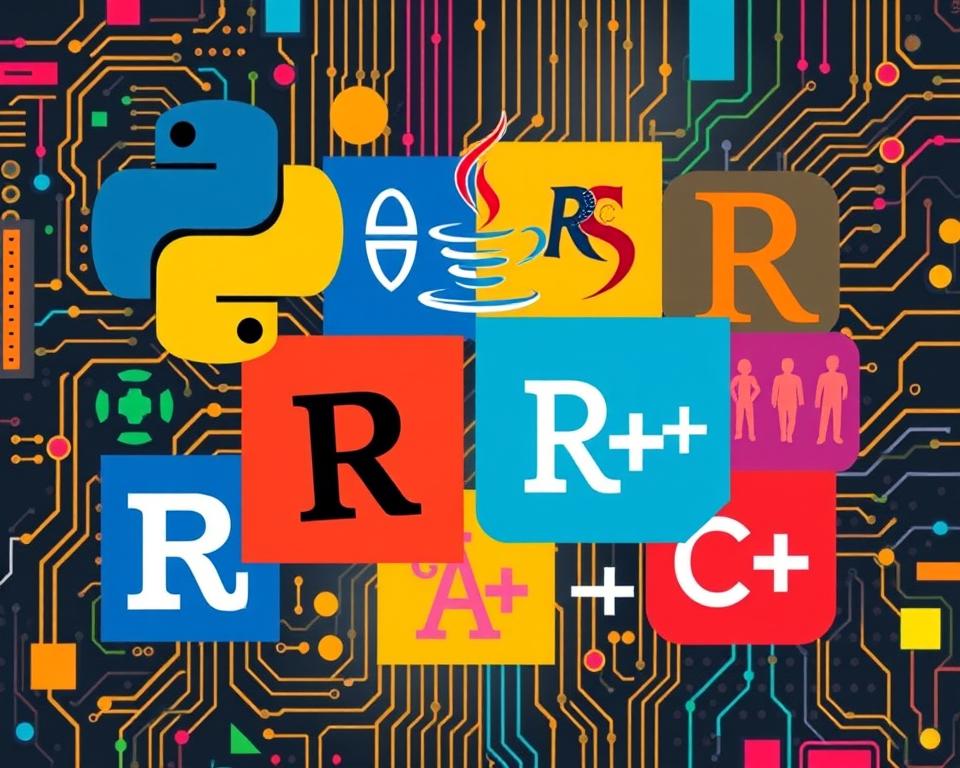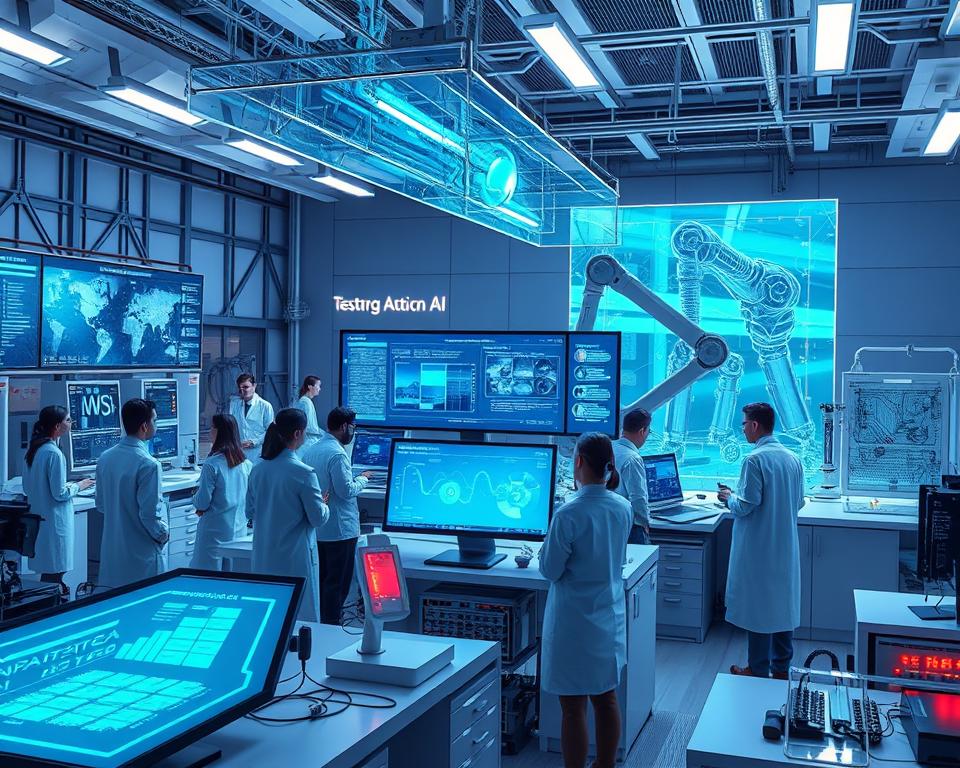Artificial Intelligence is changing the tech world, and AI Development is leading this change. It uses Machine Learning to make technology smarter. Understanding AI Development and its uses is key.
AI Development makes systems that can do things humans do, like learn and solve problems. Machine Learning helps these systems get better with time. Keeping up with AI’s growth is important.
Table of Contents
Key Takeaways
- Artificial Intelligence is transforming the technological landscape
- AI Development involves the creation of intelligent systems
- Machine Learning is a subset of Artificial Intelligence
- AI Development has numerous potential applications
- Staying informed about the latest trends and advancements is crucial
- AI Development requires a deep understanding of key essentials and concepts
Understanding the Foundation of Artificial Intelligence
Artificial intelligence (AI) is changing how we live and work fast. To get AI, we need to know its core ideas. These include machine learning, natural language processing, and computer vision. These help machines do things that humans usually do.
The historical evolution of AI has seen big steps. From the first AI program in the 1950s to today’s deep learning. AI can be narrow, general, or superintelligent, each with its own uses.
Some key AI ideas are:
- Machine learning: lets machines get better with data over time
- Natural language processing: helps computers talk to humans in our language
- Computer vision: lets computers see and understand pictures and videos
Knowing about AI’s base helps us see its big impact. It can change many areas and how we live and work.
| AI Type | Description |
|---|---|
| Narrow or Weak AI | Designed to perform a specific task, such as facial recognition or language translation |
| General or Strong AI | Able to perform any intellectual task that a human can, with the potential to surpass human intelligence |
| Superintelligence | Significantly more intelligent than the best human minds, with the potential to solve complex problems that are currently unsolvable |
Also Read : AI Development Solution
The Key Fundamentals of AI Development in Modern Technology
AI Development Fundamentals are key to making AI systems work well. Modern AI Technology uses data, algorithms, and learning machines. These basics help create smart systems that can learn, think, and talk to us.
Handling big data is a big part of AI development. AI Development Fundamentals lay the groundwork for AI systems. Important parts include:
- Data preprocessing and feature engineering
- Algorithm selection and implementation
- Model training and optimization
In Modern AI Technology, learning from data is crucial. This is where AI Development Fundamentals shine. They help make AI systems better over time.
Keeping up with AI’s growth is vital. By staying current with Modern AI Technology, developers can make groundbreaking AI. This changes industries and how we live and work.
By focusing on AI Development Fundamentals and keeping up with Modern AI Technology, developers can unlock AI’s full power. They can make smart systems that add value and better our lives.
| AI Development Fundamentals | Modern AI Technology |
|---|---|
| Data processing and analysis | Machine learning and deep learning |
| Algorithm selection and implementation | Natural language processing and computer vision |
| Model training and optimization | Edge AI and IoT applications |
Machine Learning: The Building Blocks
Machine learning is key to AI growth, letting systems get better with time. It uses different learning types like Supervised, Unsupervised, and Reinforcement Learning.
Types of Machine Learning
There are many machine learning types, each with its own benefits and drawbacks. These include:
- Supervised Learning: This method trains models on labeled data. It helps them learn from input and output relationships.
- Unsupervised Learning: This method trains models on data without labels. It helps them find patterns and connections in the data.
- Reinforcement Learning: This method trains models to act in environments. The goal is to get the most reward or avoid penalties.
Knowing the different machine learning types helps developers pick the best one for their needs. Whether it’s for image classification, natural language processing, or predictive analytics.
Machine learning is used in many real-world ways, like image recognition and natural language processing. As it keeps growing, we’ll see even more cool uses of machine learning in the future.
Neural Networks and Deep Learning Architectures
Neural Networks are key in AI, letting machines learn and get better with time. They mimic the brain, with layers of nodes that handle and share info. Deep Learning uses many layers to dig into data and guess outcomes.
In AI, these networks tackle tough challenges like seeing images, understanding words, and making choices. For example, Convolutional Neural Networks excel in image tasks, while Recurrent Neural Networks shine in word tasks. Their uses are wide, and they could change healthcare, finance, and travel.
- They do complex tasks better and more accurately.
- They learn from big data and get smarter over time.
- They’re flexible and work well in many areas.
As AI grows, Neural Networks and Deep Learning will be more vital. They help make smarter systems that tackle real issues and enhance lives. With Neural Networks, Deep Learning, and AI, the future is full of endless possibilities.
Data Processing and Preparation for AI Systems
Data processing is key in AI development. It helps make high-quality datasets for training and testing AI models. This process includes collecting, cleaning, and engineering data features. These steps are vital for getting data ready for AI systems.
There are many ways to collect data, like data mining, web scraping, and crowdsourcing. Each method has its own benefits and drawbacks. The choice depends on the project’s needs. For instance, data mining is great for big data, while web scraping is good for online data.
Data cleaning is also crucial. It removes errors and handles missing values and outliers. Feature engineering is important too. It picks and transforms key data features for AI models. These steps help create top-notch datasets for AI systems.
Some common data processing techniques for AI include:
- Data normalization
- Feature scaling
- Data transformation
These methods enhance data quality. They prepare it for AI systems, which is essential in the data processing and AI data preparation journey.
Essential Programming Languages for AI Development
Choosing the right programming language is key for AI development. AI Programming Languages like Python and R are top picks. Python stands out because it’s simple and flexible, perfect for AI Programming Languages work.
Python’s big win is its vast libraries, including TensorFlow and Keras. R is a top pick for data analysis and visualization. It’s a favorite in academic and research circles. Here’s what makes these languages special:
- Python: easy to learn, flexible, and has lots of libraries
- R: great for data analysis and visualization, loved by academics
Other languages, like Julia, are also making waves in AI. Picking the right language depends on your project’s needs. The right choice can make AI development smoother and more efficient.
Python and R are vital for AI development, offering many benefits. Knowing each language’s strengths helps developers make smart choices. This leads to innovative AI solutions.
| Language | Key Features | Applications |
|---|---|---|
| Python | Easy to learn, flexible, extensive libraries | Machine learning, natural language processing, computer vision |
| R | Ideal for data analysis and visualization, popular in academic and research communities | Data analysis, data visualization, statistical modeling |
Algorithm Selection and Implementation
Choosing the right algorithm is key in AI development. AI Algorithms fall into types like Classification, Regression, and Clustering. Each has its own strengths and weaknesses, making the right choice crucial.
Classification algorithms predict categorical labels, useful in image recognition and natural language processing. Regression algorithms predict continuous values, ideal for forecasting and optimization.
Classification Algorithms
Classification algorithms are great for tasks like spam detection and sentiment analysis. They include decision trees, random forests, and support vector machines.
Regression Models
Regression models predict continuous values, useful for tasks like stock price prediction and energy consumption forecasting. They include linear regression, logistic regression, and polynomial regression.
The right algorithm depends on the problem and data characteristics. By choosing and implementing the right algorithm, developers can create valuable AI systems.
| Algorithm Type | Description | Applications |
|---|---|---|
| Classification | Predict categorical labels | Image recognition, natural language processing |
| Regression | Predict continuous values | Forecasting, optimization |
| Clustering | Group similar data points | Customer segmentation, anomaly detection |
Model Training and Optimization Strategies
Effective model training is key for making AI systems accurate and reliable. This means using high-quality data to help the model learn and get better over time. Optimization strategies are also crucial. They help developers fine-tune the model’s performance to get the best results.
Hyperparameter tuning is a big part of optimization strategies. It’s about adjusting the model’s parameters to make it work better on specific tasks or datasets. Using methods like cross-validation and grid search helps find the best hyperparameters. This can greatly boost the model’s accuracy and efficiency, making it more useful in real-world scenarios.
- Regularization techniques, such as L1 and L2 regularization
- Early stopping, to prevent overfitting and improve generalization
- Batch normalization, to normalize the input data and improve stability
By using these optimization strategies and techniques, developers can make AI models that are very accurate and efficient. These models can solve complex problems and make smart decisions. This is especially important in areas like image recognition, natural language processing, and predictive analytics, where being accurate and reliable is essential.
Testing and Validation Methods in AI Development
AI testing is key in the development process. It makes sure the model works as it should. Validation methods, like Cross-Validation, check how well the model does with new data. This stops the model from being too specific and ensures it works well with new data.
Techniques like holdout method, k-fold Cross-Validation, and leave-one-out Cross-Validation are used in AI testing. They help see how well the model does and where it can get better. For instance, Cross-Validation splits data into training and testing parts. Then, it switches these parts to see how the model does with each.
Here are some good things about using Cross-Validation in AI testing:
- It makes the model better
- It reduces overfitting
- It boosts confidence in predictions
Using these methods, developers can make sure their AI models are accurate and reliable. This is very important in fields like healthcare, finance, and transportation. AI models make big decisions there, and they need to be right.
| Technique | Description |
|---|---|
| Holdout Method | Splitting the data into training and testing sets |
| k-fold Cross-Validation | Splitting the data into k subsets and rotating the subsets to evaluate the model’s performance |
| Leave-one-out Cross-Validation | Splitting the data into training and testing sets, with one sample left out for testing |
Ethical Considerations in AI Development
As AI technology grows, AI Ethics is key. We must tackle risks like Bias and job loss to ensure Fairness and clearness.
Important ethical points in AI include:
- Ensuring accountability and transparency in AI decision-making processes
- Addressing potential biases in AI algorithms and data
- Protecting user privacy and security
By focusing on AI Ethics, we can make AI systems fair and useful. This needs a team effort from tech, philosophy, and social sciences experts.
Creating AI that is fair and ethical is vital. It builds trust and ensures AI’s success in the future.
| AI Ethics Considerations | Importance |
|---|---|
| Bias and Fairness | High |
| Transparency and Accountability | High |
| Privacy and Security | High |
Real-World Applications and Use Cases
AI Applications are changing many industries. They have a huge potential. In Healthcare, AI helps improve patient care and makes clinical work easier. For example, AI chatbots give patients health advice tailored to them.
In Finance, AI spots and stops fraud, and gives investment tips to clients. Big names like Goldman Sachs and JPMorgan Chase use AI to better their services.
Key Industries Benefiting from AI
- Healthcare: AI is being used to improve patient outcomes, streamline clinical workflows, and provide personalized health advice.
- Finance: AI is being used to detect and prevent fraudulent transactions, provide personalized investment advice, and improve financial services.
- Manufacturing: AI is being used to improve supply chain management, predict maintenance needs, and optimize production processes.
As AI grows, we’ll see more new uses in different fields. It can handle huge data sets, changing how we live and work.
| Industry | AI Application | Benefits |
|---|---|---|
| Healthcare | Patient outcome improvement | Improved patient care, reduced costs |
| Finance | Fraud detection and prevention | Reduced risk, improved security |
| Manufacturing | Supply chain optimization | Improved efficiency, reduced costs |
Common Challenges and Solutions in AI Development
AI development faces many hurdles. One big AI Challenge is making sure the data used to train models is good. Bad data can lead to wrong or unfair results, which can cause big problems. To fix this, developers need to check and clean the data well.
Another big Limitation is making AI systems clear and easy to understand. As AI gets more complex, it’s hard to see how it makes decisions. This makes it tough to find and fix errors or biases. To solve this, developers use methods like feature attribution or model explainability to shed light on how AI decides things.
Even with these challenges, AI is an exciting and fast-growing field. By tackling the AI Challenges and Limitations, developers can make better and more reliable Solutions. These solutions have the power to change industries and make life better for everyone.
Future Trends and Emerging Technologies
The AI future is changing fast, with new technologies leading the way. Quantum computing, for example, could make AI much faster. It’s set to help create smarter AI models, especially in machine learning and deep learning.
Edge AI is another big area. It means processing data right where it’s needed, making decisions quicker. This is great for things like self-driving cars, smart homes, and factory automation. As Edge AI gets better, AI systems will work more smoothly and quickly.
Quantum Computing in AI
Quantum computing is a big deal for AI. It brings incredible power and speed. This lets researchers solve problems that were too hard before, like optimizing complex systems and understanding complex phenomena.
Edge AI Development
Edge AI is getting more important. It lets AI systems work in real-time, without needing the cloud. This is key for things like self-driving cars or factory control systems, where speed matters a lot.
AutoML Advances
Automated machine learning (AutoML) is making big strides. It helps developers make and use AI models faster. This means businesses can start using AI sooner, without needing to know a lot about machine learning or deep learning.
As these new technologies grow, we’ll see big changes in AI. They’ll drive new ideas and changes in many fields. By using these trends and technologies, companies can find new chances, work better, and stay ahead.
Conclusion: Mastering AI Development Fundamentals
Learning the basics of AI development is key to unlocking AI’s full potential in many fields. It helps people create new solutions that change how businesses work. Knowing how to process data and use machine learning is essential for making AI systems work well.
The need for AI solutions is growing fast. Companies like Google, Microsoft, and Amazon are spending a lot on AI research. This creates chances for those skilled in AI development to grow their careers.
For those eager to learn more about AI, many resources are out there. Places like Stanford University and MIT offer online courses and tutorials. By using these resources and keeping learning, you can become an expert in AI development and find new job opportunities.



















